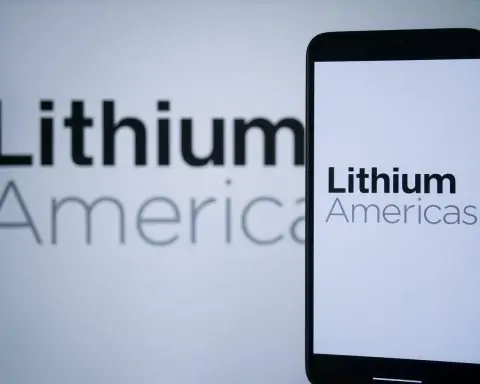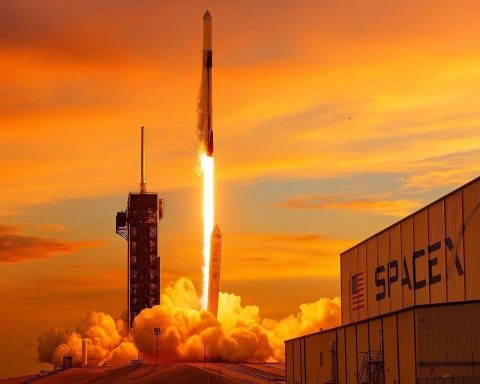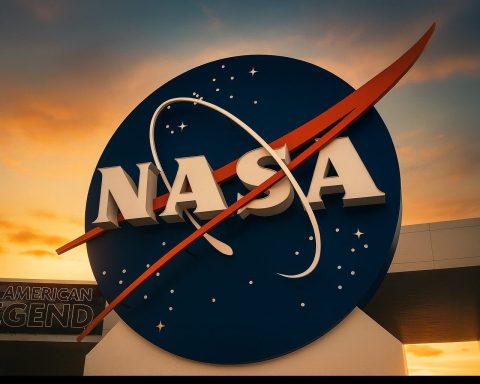- SpaceX launched 28 Starlink satellites from Cape Canaveral, Florida at 11:37 p.m. EDT on July 29, 2025, and the Falcon 9 first stage landed on the drone ship “Just Read the Instructions,” marking the booster’s 26th flight and pushing Starlink to over 8,000 active satellites.
- SpaceX marked its 96th launch of 2025 on July 29, 2025, underscoring a near-daily cadence for the year.
- NASA’s Crew-11 mission to the International Space Station is targeted for liftoff on July 31, 2025 at 12:09 p.m. EDT from the Kennedy Space Center, with four astronauts including Mike Fincke and a multinational crew, and NASA’s interim administrator Sean Duffy attending.
- Firefly Aerospace won a $176.7 million NASA CLPS contract to deliver five NASA payloads to the Moon’s south pole in 2029 using Firefly’s Blue Ghost lander and the Elytra Dark transfer vehicle.
- The Lunar Exploration Ground Stations (LEGS) procurement was paused due to budget uncertainties, delaying new lunar communication ground stations.
- NASA confirmed a historic in-person meeting with Roscosmos chief Dmitry Bakanov on the sidelines of the Crew-11 launch, the first since 2018, to discuss cross-crew flights, ISS life extension to 2030, and a safe deorbit plan.
- NISAR, the NASA-ISRO Synthetic Aperture Radar satellite, is scheduled to lift off July 30, 2025 at 5:40 p.m. IST (8:10 a.m. EDT) on ISRO’s GSLV Mk II from Sriharikota, weighing 2,400 kg with a 12-meter deployable radar antenna, mapping the globe every 12 days.
- Canada awarded CAD 14.6 million (US$10.6 million) in contracts to Canadensys Aerospace, MDA, and Mission Control for early lunar rover design studies, a plan to build a 3,500 kg cargo-capable rover that could operate semi-autonomously for 10 years and create about 200 high-tech Canadian jobs.
- iSpace’s Hyperbola-1 rocket scored its first successful orbital launch in over a year on July 29, 2025 from Jiuquan, carrying a small remote-sensing satellite.
- The U.S. Space Force awarded initial Protected Tactical Satcom (PTS-G) design contracts to Boeing, Northrop Grumman, Viasat, Intelsat and Astranis totaling $37.2 million, with a down-select by early 2026 and a demonstration satellite planned for 2028, potentially totaling up to $4 billion.
A Frenetic 48 Hours in Space
The past two days have unleashed a torrent of major space news, from record-breaking satellite launches to groundbreaking international collaborations. In just 48 hours, SpaceX notched yet another Starlink mega-launch, NASA inked a new Moon mission deal with a private firm, the United States and India geared up for a landmark satellite launch, and even NASA’s interim chief sat down with Russia’s space boss for the first time in years. Here’s your comprehensive roundup of the satellite and space highlights from July 29–30, 2025.
SpaceX’s Starlink Blitz and Crew Mission Prep
Another 28 Starlink Satellites Soar: SpaceX capped Tuesday night with the launch of 28 more Starlink broadband satellites from Cape Canaveral, Florida [1]. Liftoff occurred at 11:37 p.m. EDT on July 29, and about nine minutes later the Falcon 9 rocket’s first stage landed safely on the drone ship “Just Read the Instructions” in the Atlantic [2]. This mission marked the 26<sup>th</sup> flight of that reusable booster, tying SpaceX’s own reuse record. It also pushed SpaceX’s Starlink constellation to over 8,000 active satellites in orbit (out of ~9,300 launched since 2018) [3], underscoring the company’s breakneck deployment of its internet megaconstellation. According to satellite tracker Jonathan McDowell, SpaceX’s constellation now far outnumbers any other, a presence that is both revolutionizing global internet access and raising orbital traffic concerns.
Launch #96 of 2025: Incredibly, this Starlink mission was SpaceX’s 96<sup>th</sup> launch of the year [4] – an unprecedented cadence that highlights SpaceX’s dominance in commercial launch. “All but three” of those flights were Falcon 9 missions, with only a few on Falcon Heavy [5]. And SpaceX isn’t slowing down: another Starlink launch was slated for the very next day (July 30) from California, and a high-profile crewed mission is on deck as well [6]. The company’s relentless pace has effectively made near-daily launches the new normal in 2025.
Crew-11 Astronauts Ready for Liftoff: At NASA’s Kennedy Space Center, a Falcon 9 and Dragon capsule are being prepared to loft NASA’s SpaceX Crew-11 mission to the International Space Station (ISS). Liftoff is targeted for July 31 (Thursday) at 12:09 p.m. EDT, with four astronauts aboard – a multinational crew heading to Expedition 75 on the ISS [7] [8]. Among them is veteran NASA astronaut Mike Fincke and crewmates from Japan, Europe, and Russia, reflecting the ISS program’s global partnership. In fact, the interim head of NASA, Sean Duffy, will be on hand in Florida for the launch [9]. This crew mission comes on the heels of the private Axiom-4 mission earlier in July (which carried astronauts from India, Poland and Hungary alongside American Peggy Whitson). Together, these flights signal a surge in human spaceflight activity – both governmental and commercial – as SpaceX’s Dragon continues to ferry diverse crews to orbit with routine frequency.
NASA Bets on the Moon: Private Contracts and Lunar Tech
Firefly Wins $176.7 M Lunar Lander Deal: NASA’s push to return to the Moon took a big leap on July 29 as the agency awarded Firefly Aerospace a $176.7 million contract to deliver science payloads to the Moon’s south pole in 2029 [10]. This mission – Firefly’s fourth Moon sortie under NASA’s Commercial Lunar Payload Services (CLPS) program – will use the Texas-based startup’s Blue Ghost lander and new Elytra Dark transfer vehicle to carry five NASA-sponsored payloads, including two rovers (one from NASA and one from the Canadian Space Agency) and three scientific instruments [11] [12]. The goal: assess vital resources like lunar water ice and gauge radiation and thermal conditions to pave the way for future astronauts [13] [14].
Firefly’s leadership hailed the win as validation of the growing role of nimble private firms in deep space exploration. “Firefly is honored to support another NASA CLPS mission as a proven, reliable partner for robotic missions to the Moon,” said Firefly CEO Jason Kim, noting that the company’s first Moon landing earlier this year completed all its objectives. “This bold Firefly team proved we have the right mix of grit, innovation, and dedication to not only stick the landing, but also complete all scientific objectives for our payload partners,” Kim said of their March lunar touchdown [15]. Firefly’s inaugural Blue Ghost lander mission in March made headlines as the first fully successful commercial lunar landing, and the company now aims to repeat that success and more. Notably, Firefly plans to keep its Elytra Dark orbital vehicle loitering around the Moon for five years after deployment to support lunar reconnaissance services [16] – essentially creating an orbiting lunar relay and imaging platform that future customers can tap into.
Lunar Communication Plans Paused: Even as NASA partners with companies for Moon deliveries, it is rethinking how to support these missions from Earth. Citing budget uncertainties, the agency quietly paused a project to build new lunar communication ground stations meant to ease the burden on NASA’s Deep Space Network [17]. The Lunar Exploration Ground Sites (LEGS) initiative was supposed to add dedicated antennas for near-Earth and lunar missions, but procurement is on hold for now [18]. That reflects broader fiscal pressures on Artemis infrastructure – a reminder that ambitious Moon plans still face Earth-bound funding realities.
Historic NASA–Roscosmos Meeting Amid Tensions
In a rare bit of positive U.S.–Russian space news, NASA confirmed that acting Administrator Sean Duffy will meet this week with Dmitry Bakanov, the head of Russia’s Roscosmos space agency [19]. It will be the first in-person meeting of NASA and Roscosmos chiefs since 2018 [20], breaking a seven-year freeze in top-level dialogue. The talks, expected to occur on the sidelines of the Crew-11 launch in Florida, come at a fraught time: U.S.–Russian relations are strained over the Ukraine conflict, and Russia has signaled plans to eventually depart the ISS program.
Despite geopolitical strains, Duffy emphasized the importance of keeping space cooperation alive. “We have wild disagreement with the Russians on Ukraine,” he told reporters, acknowledging the elephant in the room. But he noted that the two nations remain partners on the International Space Station, and he’s determined to find “points of agreement, points of partnership” in space. “Through hard times, we don’t throw those relationships away,” Duffy said, stressing that the long-standing ISS partnership can serve as a bridge even when Earthly politics falter [21] [22]. The Roscosmos side has signaled similar intent: Bakanov said the agenda will include continuing cross-crew flights (swapping seats between U.S. and Russian spacecraft), extending the ISS’s life, and coordinating a safe deorbit plan for the station when the time comes [23].
This meeting is highly symbolic. It underscores that space remains one of the few arenas of U.S.–Russian collaboration not completely severed by international conflict. Both agencies have practical reasons to talk: NASA wants Russia to remain engaged with ISS through 2030, and Russia’s plans for a new orbital station are still nascent. For now, the ISS partnership’s 25-year legacy of working “through hard times” is something neither side is ready to jettison [24]. As Duffy put it, “We’re going to continue to build alliances and partnerships and friendships as humanity continues to advance in space exploration.” [25] All eyes will be on how this delicate diplomatic dance plays out in the coming days.
US–India Launch Powerful Earth-Monitoring Satellite
NISAR Set for Liftoff: In a major milestone for international space cooperation, the United States and India are about to launch a groundbreaking Earth-observation satellite together. The NASA-ISRO Synthetic Aperture Radar satellite (NISAR) is scheduled to lift off July 30 at 5:40 p.m. IST (8:10 a.m. EDT) on an Indian GSLV rocket from Sriharikota [26]. Billed as “a formidable new radar satellite”, NISAR will use advanced dual-frequency radars (L-band from NASA and S-band from ISRO) to scan Earth’s land and ice surfaces in unprecedented detail [27]. It will be capable of detecting millimeter-level changes in terrain – crucial for tracking climate change effects, natural hazards like earthquakes and floods, agricultural trends, and more.
Indian officials are hailing NISAR as a “historic moment in India’s space journey” and a model for global scientific partnership [28]. “Calling it ‘India’s scientific handshake with the world’, Dr. Jitendra Singh – India’s Minister of State for Science & Technology – said the mission reflects the growing maturity of Indo-US collaborations and the expanding role of ISRO in international space initiatives [29]. It’s India’s first major satellite jointly developed with the U.S., and the enthusiasm is palpable. “This mission will benefit not just India and the US but many countries around the world. It will provide critical data in areas such as disaster management, climate change, agriculture, and more,” Dr. Singh noted [30]. Indeed, NISAR’s data (which will be openly available within 1–2 days of collection) could help emergency responders worldwide by providing rapid imagery after disasters, and assist scientists in monitoring Earth’s vital signs with a level of precision not previously available [31].
Technically, NISAR is a marvel: a 2,400 kg satellite sporting a huge 12-meter deployable radar antenna contributed by NASA [32]. NASA provided the L-band radar, high-speed telecom system, GPS receivers and the giant foldable mesh antenna, while ISRO built the satellite bus, S-band radar, and is providing the hefty GSLV Mk II rocket for launch [33]. Notably, this will be the first time India’s GSLV (a heavy-lift vehicle) launches a payload into a sun-synchronous polar orbit, demonstrating enhanced capability by ISRO [34]. If all goes to plan, NISAR will map the entire globe every 12 days, generating an unprecedented record of Earth’s dynamics.
Beyond the science, the symbolism of NISAR looms large. It comes on the heels of President Biden and Prime Minister Modi’s pledges to deepen space cooperation. As Dr. Singh put it, NISAR is “not just a satellite launch, but a powerful symbol of how two democratic nations can come together to serve global scientific needs.” [35] It underscores India’s emergence as a key player in big-ticket space missions and the fusing of talent between NASA and ISRO. With India also eyeing human spaceflight and lunar missions, and the U.S. courting partners for Artemis, NISAR’s success could herald even bolder joint endeavors in the future.
Canada Invests in a Lunar Rover – and Jobs
Ottawa Funds Artemis Utility Rover Studies: Canada signaled its Moon ambitions on July 29 by awarding C$14.6 million (US$10.6 M) in contracts to three domestic companies for early design studies of a lunar utility rover [36]. The Canadian Space Agency’s vision is to build a multi-purpose rover to support astronauts on the Moon as part of NASA’s Artemis program. The concept: a rugged vehicle capable of transporting cargo, assisting in construction, and even carrying crew around the lunar surface in the future [37] [38].
The contracts went to Canadensys Aerospace, MDA, and Mission Control – firms that collectively will explore rover options over the next 18 months [39]. It’s the first phase of a planned 13-year, C$1.2 billion program to develop this rover, which Canada hopes to contribute to the Artemis effort in exchange for astronaut flight opportunities [40]. (Canada already secured a seat on the Artemis II lunar flyby in 2024, and a future Artemis landing, by providing the Gateway space station’s robotic arm. A new rover would further cement its role in lunar exploration.) Procurement will emphasize Canadian content and industry growth, officials said, with requirements for majority-domestic sourcing to boost local innovation [41].
“Shaping the Next Era of Lunar Exploration”: Canada’s Minister of Industry, Mélanie Joly, underscored the broader significance of the rover program. “Through the design and development of this lunar utility rover, Canada will collaborate with international partners to shape the next era of human exploration of the Moon,” Joly said in a July 29 announcement [42]. She highlighted that this initiative is not only about science but also about economic opportunity. Advancing a lunar rover “has the potential to open doors for Canadian businesses to expand and compete internationally,” Joly noted, and is expected to create or sustain 200 high-tech jobs in Canada over the next decade [43]. In a nation proud of its “Canadarm” legacy on the shuttle and ISS, this rover is positioned as the next leap – inspiring innovation at home while contributing to humanity’s return to the Moon.
Mission Control CEO Ewan Reid, whose company will design rover software and autonomy under a C$4.7 M contract, called the project a natural evolution. After working on dozens of lunar tech projects (from AI software to components on past rovers that unfortunately crash-landed), “it made sense to evolve into a full rover provider,” Reid said, expressing confidence that Canadian expertise can meet the challenge [44] [45]. The target rover would be a beast: envisioned to carry 3,500 kg of cargo – akin to a pickup truck on the Moon – and operate semi-autonomously for 10 years [46] [47]. While only one of the three study participants may ultimately build the rover, Canada is even considering a U.S.-style approach of supporting multiple suppliers to encourage competition [48]. It’s an ambitious plan, but if realized, the maple leaf could soon be emblazoned on a workhorse lunar rover helping astronauts build the first permanent base on the Moon.
Commercial Launch Highlights: China’s iSpace Comeback
It’s not just SpaceX making noise in launch news. In China, a scrappy startup achieved a notable comeback on July 29. iSpace, a Beijing-based private launch firm, successfully flew its Hyperbola-1 solid-fueled rocket to orbit from Jiuquan Satellite Launch Center – its first successful orbital launch in over a year [49]. The four-stage Hyperbola-1 booster lifted off Tuesday carrying a small remote-sensing satellite, marking iSpace’s return to form after multiple failures of this vehicle since 2019 [50]. The mission’s success is a morale boost for China’s nascent commercial space sector, which has seen a mix of triumphs and setbacks as various startups race to reach orbit.
iSpace was the first Chinese private company to orbit a satellite (back in 2019), but a string of launch failures had stalled its momentum. Tuesday’s flight suggests the kinks have been worked out, at least for now. It also reflects a wider surge in Chinese launch activity: dozens of state and private missions are scheduled this year as China builds out constellations for communications and Earth observation. Just last week, a government Long March 2D rocket launched Beijing’s multi-satellite Ionosphere exploration mission from Jiuquan, and coming up China plans to test a methane-fueled launcher and continue space station resupply flights. With iSpace back in the game, competition among Chinese commercial launchers (like Galactic Energy, LandSpace, and others) is only intensifying – mirroring the busy field in the U.S. albeit with heavy state guidance. For the global market, iSpace’s return adds another potential player offering smallsat launch services in the future.
In other launch news: Australia’s first orbital rocket attempt – Gilmour Space’s Eris rocket – made headlines on July 30, but unfortunately failed on its debut flight, according to reports from Abbot Point, Australia [51] [52]. And Rocket Lab, fresh off a record month in June where it launched two Electron rockets just 47 hours apart, is preparing for its next mission from New Zealand. The flurry of activity worldwide underscores that the “new space race” is truly global and commercial at its core. Even as established players notch milestones, newcomers are pushing boundaries (and sometimes faltering, as expected). The overall trend is clear: more rockets from more places are reaching for orbit than ever before.
Space Policy and Defense: US Bets on Commercial Satcom
On the defense side of the space industry, the U.S. Space Force announced a significant step in modernizing its satellite communications for warfighters. The military on July 28 (revealed publicly July 29) awarded initial design contracts to five companies for a new Protected Tactical Satcom (PTS) network [53] [54]. The firms – Boeing, Northrop Grumman, Viasat, Intelsat and upstart Astranis – will split $37.2 million in funding to develop prototype concepts for a constellation of jam-resistant communications satellites in geostationary orbit [55]. This marks a notable embrace of commercial “new space” players: alongside aerospace giants, the Space Force deliberately included Astranis, a venture-funded company known for small GEO satellites, as well as a partnership where Intelsat will use a satellite bus from startup K2 Space [56].
The program, dubbed PTS-G, could be worth up to $4 billion as it progresses [57]. Over the next six months, each vendor will design a prototype satellite or payload. By early 2026, the Space Force plans to down-select to one design and fund a full demonstration satellite for launch in 2028 [58]. Additional satellites would follow if all goes well. The stakes are high: the goal is to replace or supplement legacy military satcom with a resilient network that can withstand jamming and cyber-attacks, ensuring secure communications for deployed forces. The approach is also novel for the Pentagon – moving away from sole-sourcing billion-dollar satellites toward a “buy small, fly often” model influenced by the commercial sector’s rapid development style [59].
A Space Force program executive, Cordell DeLaPena Jr., said the strategy reflects a culture shift. “Our PTS-G contract transforms how [Space Systems Command] acquires SATCOM capability for the warfighter,” DeLaPena noted, highlighting that “the incorporation of commercial baseline designs to meet military capability significantly enhances the Space Force’s speed and efficiency to add capability to meet emerging threats.” [60] In other words, by tapping companies that already build cutting-edge comsats (or have innovative designs on the shelf), the Space Force hopes to deploy new secure communications far faster than the old development timelines. This move has been cheered by many in the industry as a win-win: the military gets access to the latest tech and agile production, while commercial space firms get a crack at lucrative defense contracts traditionally reserved for prime contractors.
Also of note in space policy, France’s government reported progress in talks to create a European satellite constellation venture to rival Starlink – part of the EU’s broader push for secure independent communications [61]. And in Washington, D.C., lawmakers are weighing proposals on space traffic management and commercial regulation as satellite numbers explode. Regulatory chatter aside, the clear takeaway from these two days is that space activity is ramping up on all fronts – civilian, commercial, and military – and the pace shows no signs of slowing.
Conclusion: A New Era Dawns Above
From the flurry of announcements and achievements on July 29–30, it’s evident we are living through a new space renaissance. Long-established space agencies like NASA are forging fresh alliances and embracing private partners to meet their exploration goals. Rising spacefaring nations and startups are carving out their place in Earth orbit and beyond. Even geopolitical rivals are finding ways to keep cooperation alive off-planet, recognizing that in the vacuum of space, dialogue can be easier than on Earth.
These 48 hours brought dramatic illustrations of both collaboration and competition: the U.S. and India uniting for the good of Earth’s climate; Canada and Japan investing in Artemis; China’s commercial sector rebounding; and SpaceX pushing the envelope of launch frequency. At the same time, powers like the U.S. are leveraging commercial innovation for defense, and Europe is strategizing its response to private megaconstellations.
If there is one thread connecting all these developments, it’s acceleration. More satellites launched, more missions planned, more countries involved – all at a breakneck pace that would have seemed fanciful a decade ago. As we close out this whirlwind roundup, one can’t help but feel excitement at the possibilities unfolding above us. As humanity’s presence in space grows, so too does the need for wise stewardship, cooperation, and yes, a healthy dose of competitive spirit to drive us further. Buckle up – the new space race is on, and everyone on planet Earth stands to benefit from the innovations and discoveries to come [62] [63].
Sources: Official releases and news reports from NASA, SpaceX, Reuters, SpaceNews, Space.com, and other agencies and publications [64] [65] [66] [67] [68] [69] [70]. Each development described above has been confirmed by reputable sources, as linked throughout this article.
References
1. www.space.com, 2. www.space.com, 3. www.space.com, 4. www.space.com, 5. www.space.com, 6. www.space.com, 7. www.reuters.com, 8. www.space.com, 9. www.reuters.com, 10. www.reuters.com, 11. www.reuters.com, 12. fireflyspace.com, 13. fireflyspace.com, 14. fireflyspace.com, 15. fireflyspace.com, 16. www.reuters.com, 17. spacenews.com, 18. spacenews.com, 19. www.reuters.com, 20. www.reuters.com, 21. www.reuters.com, 22. www.reuters.com, 23. www.reuters.com, 24. www.reuters.com, 25. www.reuters.com, 26. www.indiatribune.com, 27. www.indiatribune.com, 28. www.indiatribune.com, 29. www.indiatribune.com, 30. www.indiatribune.com, 31. www.indiatribune.com, 32. www.indiatribune.com, 33. www.indiatribune.com, 34. www.indiatribune.com, 35. www.indiatribune.com, 36. spacenews.com, 37. spacenews.com, 38. spacenews.com, 39. spacenews.com, 40. spacenews.com, 41. spacenews.com, 42. spacenews.com, 43. spacenews.com, 44. spacenews.com, 45. spacenews.com, 46. spacenews.com, 47. spacenews.com, 48. spacenews.com, 49. spacenews.com, 50. spacenews.com, 51. www.space.com, 52. www.space.com, 53. spacenews.com, 54. techcrunch.com, 55. spacenews.com, 56. techcrunch.com, 57. techcrunch.com, 58. techcrunch.com, 59. techcrunch.com, 60. techcrunch.com, 61. www.reuters.com, 62. www.reuters.com, 63. www.indiatribune.com, 64. www.reuters.com, 65. www.reuters.com, 66. www.space.com, 67. fireflyspace.com, 68. www.indiatribune.com, 69. spacenews.com, 70. techcrunch.com










